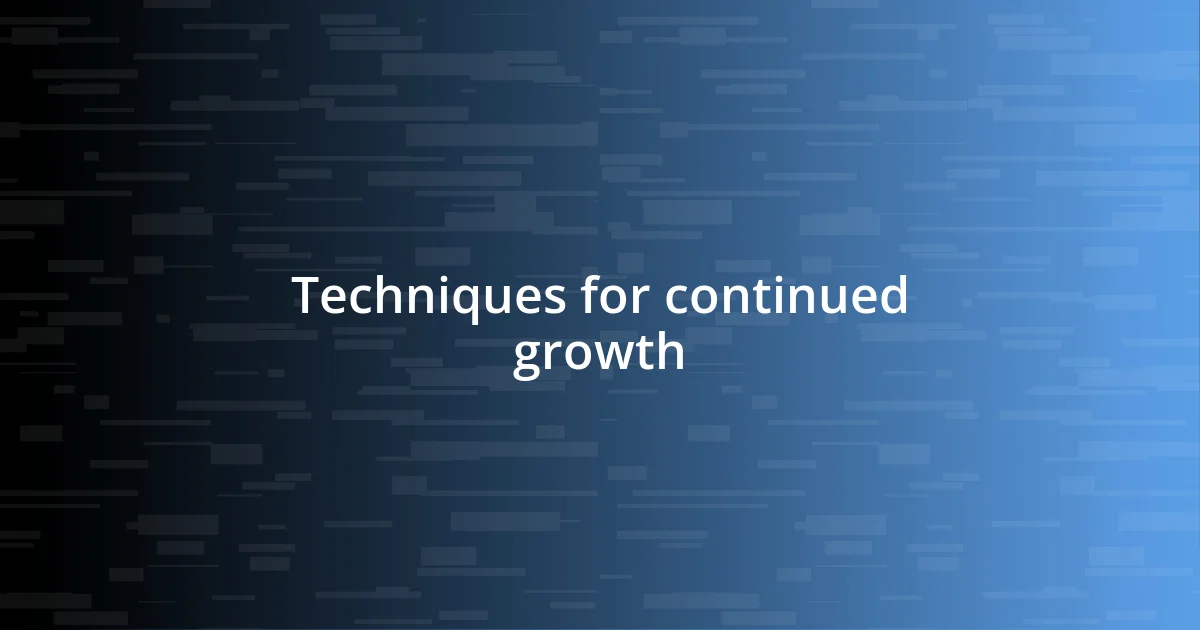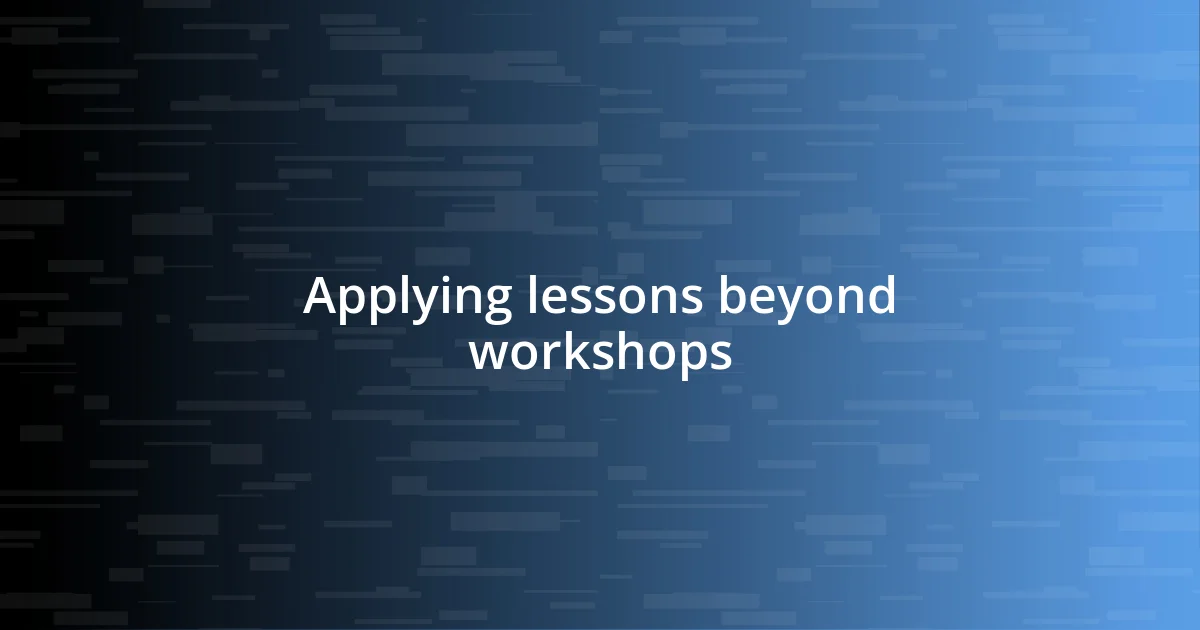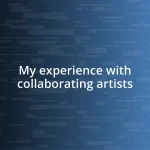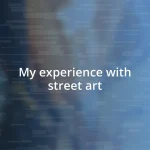Key takeaways:
- Shift in mindset: Understanding that art is about expression, not perfection, enhances creativity.
- Feedback fosters growth and community: Constructive criticism and mutual learning during critiques strengthen skills and bonds among artists.
- Lessons extend beyond art: Techniques for creativity and perspective acquired in workshops can be applied to everyday life and professional challenges.

My art workshop experiences
My first art workshop was a whirlwind of emotions. I remember standing in front of a blank canvas, feeling a mix of excitement and anxiety. What if I couldn’t create anything worthy? But after seeing the instructor demonstrate her techniques, I realized that it wasn’t about perfection; it was about expression. That shift in mindset transformed my approach to art.
During another workshop, I found myself surrounded by a group of diverse individuals, each with unique stories and perspectives. I was struck by how art became a common language among us. I still think about how one participant shared her struggle with self-doubt, and we all nodded in understanding. Hasn’t everyone grappled with their insecurities at some point? That shared vulnerability fostered an incredible sense of community that I cherish.
One particularly memorable experience was when we experimented with mixed media. I recall the thrill of layering papers and textures, creating something wildly unexpected. As I glued down a piece of newspaper from a long-forgotten headline, I started to reflect on the stories we all carry with us. Isn’t it fascinating how a simple art medium can evoke deep personal narratives? Each workshop left me not only with new skills but also with profound insights into myself and the world around me.

Skills gained from workshops
Participating in art workshops has equipped me with a range of skills that extend beyond just brush techniques. I vividly remember the moment I first grasped color theory; mixing primary colors into vibrant shades was like opening a treasure chest. This simple yet profound skill not only improved my artwork but resonated with my understanding of emotional expression through hues.
- Improved Technical Ability: Learning different painting techniques helped refine my skills.
- Color Theory Understanding: Gauding my approach to color opened new avenues of creativity.
- Creative Confidence: I felt my doubts about my abilities wane as I realized what I could produce.
- Collaboration Skills: Working alongside others taught me the power of feedback and community.
- Flexibility with Mediums: I discovered a love for watercolor that I hadn’t anticipated through experimentation.
Each workshop presented a unique opportunity to learn something new. Just last month, while learning about printmaking, I made my first linocut. That satisfying moment when I pulled the first print felt like a small victory! It reinforced my understanding that skill mastery comes with patience and practice, encouraging me to embrace the journey rather than just the end product.

Importance of feedback in art
Feedback plays a pivotal role in the art world. When I first shared my work with peers, their insights helped me see my art from a fresh perspective. One piece I was particularly proud of received constructive criticism regarding composition. It stung a little at first, but I learned to embrace that feedback; it ultimately led to a stronger final piece. Isn’t it interesting how, at times, the most valuable lessons come wrapped in honesty?
In workshops, the act of critiquing became a two-way street, enriching my understanding not only of others’ work but also of my own. Each session felt like a safe haven where sharing ideas and suggestions flourished. I remember feeling a rush of excitement when someone praised my use of shadow in a figure drawing, urging me to push that technique further. That encouragement bolstered my confidence and motivated me to explore deeper tonal variations in my future pieces. It taught me that a simple compliment, mixed with an honest suggestion, can be the perfect recipe for growth.
Interestingly, I discovered that feedback isn’t just about improvement; it’s also about connection. I recall how one critique sparked a passionate discussion among participants, revealing diverse interpretations of the same theme. It opened my eyes to the idea that art is subjective, and understanding another artist’s viewpoint can illuminate my own path. Every critique session felt like exchanging gifts—ideas, perspectives, and encouragement. That experience reminded me that feedback fosters not only skill development but also a rich sense of community that enhances the creative journey.
| Feedback Aspect | Personal Insight |
|---|---|
| Constructive Criticism | Encouraged growth through honest reflections, leading to stronger artwork. |
| Mutual Learning | Discussions deepened my understanding of art and techniques. |
| Connection | Fostered a community where shared ideas enriched our creative processes. |

Collaborating with fellow artists
Collaborating with fellow artists turned out to be one of the most enriching aspects of my workshop experiences. I once participated in a group project where each artist contributed a section to a large mural. Watching how our distinct styles blended into a cohesive piece amazed me. It was like seeing individual notes harmonize into a beautiful melody. Isn’t it incredible how we can create something larger than ourselves through collaboration?
What I really cherished were those moments of spontaneous brainstorming with fellow artists. One afternoon, while sipping coffee at a workshop, a casual conversation about our projects spiraled into a deep dive into techniques we hadn’t tried. I remember feeling a surge of inspiration as we exchanged ideas, and the energy in the room was palpable. It reminded me that collaboration is not just about sharing space; it’s about merging minds to push boundaries and ignite creativity.
There was a time when I collaborated with a photographer during a mixed-media workshop, and it blew my mind. Her perspective was fresh and different from mine, guiding me to incorporate elements I’d never considered. As we experimented, I felt a sense of excitement bubbling within me, realizing how much I could learn just by embracing her approach. Working together not only expanded my artistic horizons but also forged a bond built on mutual respect and admiration. Those shared moments were magical, making me wonder: how many more incredible ideas are hidden in the minds of others, waiting for the right moment to merge?

Overcoming creative blocks
Creative blocks can often feel like an immovable wall, but I’ve discovered some effective ways to break through them. I remember sitting in an art workshop, staring at a blank canvas, overwhelmed by the pressure to create something remarkable. A fellow artist proposed a quick brainstorming exercise: sketching anything that came to mind, no matter how random. Surprisingly, that simple act of unrestricted doodling loosened the tight grip of my self-doubt and unlocked a flood of imaginative ideas. Isn’t it fascinating how freeing your mind can open up creative channels that seemed blocked just moments before?
Another technique that worked wonders for me was altering my environment. There was a particularly gray day when I felt wholly uninspired. On a whim, I decided to take my supplies outside. As the sun peeked through the clouds, a burst of warmth washed over me, invigorating my creativity. The shadows cast by the trees invited me to paint dynamic forms I hadn’t considered before. Don’t you think the surroundings we immerse ourselves in play a vital role in shaping our creative outputs?
Additionally, embracing the notion of imperfection has been crucial in overcoming these blocks. I once attended a workshop where the instructor encouraged us to create intentionally “bad” art. It felt liberating to let go of the need for perfection and just focus on the process. I remember laughing at the absurdity of my own chaotic creations, but in that light-hearted moment, I stumbled upon unexpected textures and hues that sparked new ideas. Isn’t it remarkable how sometimes, letting go of expectations can lead you right to a creative breakthrough?

Techniques for continued growth
Techniques for continued growth can be incredibly varied, but one that consistently stands out to me is the practice of setting personal challenges. I recall one workshop where the facilitator challenged us to create a piece of art using only three colors. Initially, I felt restricted and frustrated, but this limitation sparked my creativity in unexpected ways. It taught me that growth often comes from stepping outside my comfort zone. How often do we keep ourselves in a bubble for fear of making mistakes?
Another technique that’s really helped my development is keeping a regular art journal. I’ve filled countless pages with sketches, ideas, and reflections from each workshop I’ve attended. Just recently, I flipped back through my journal and discovered techniques I had forgotten about, sparking new projects. Isn’t it amazing how the simple act of documenting our journey can become a wellspring of inspiration? I like to think of it as creating a personal map to future artistic adventures.
Lastly, seeking feedback and integrating critiques has been a game-changer for my growth. I remember presenting a piece during a workshop, filled with pride, only to receive constructive criticism that made me rethink my approach. Initially, I felt a wave of defensiveness wash over me, but later, I realized that the insights gained were invaluable. Isn’t it interesting how perceived setbacks can turn into stepping stones toward improvement? Embracing feedback not only builds resilience but also deepens my understanding of my own work and its impact.

Applying lessons beyond workshops
I’ve learned that the lessons from workshops don’t just stay in the studio; they seep into every corner of my daily life. For instance, when I faced challenges in my career, I found myself revisiting techniques for overcoming creative blocks. I remember sitting at my desk, feeling stuck on a project, and I instinctively closed my eyes, imagined the brainstorming exercises we did, and let my thoughts flow freely. It was empowering to realize that the strategies I honed with paint and canvas could serve me in professional settings, too.
Another eye-opening experience was when I began to view my everyday surroundings through an artist’s lens. After a workshop focused on observing the world around us, I started carrying a small sketchbook everywhere. It was both surprising and thrilling to capture mundane moments—like the rhythm of city life or the way light dances on water. This mindset shift helped me cultivate a deeper appreciation for my environment. Have you ever noticed how a simple shift in perspective can make the ordinary feel extraordinary?
Feedback, a vital component of workshops, unexpectedly crept into my interactions outside the art space. I remember discussing an idea with friends and recalling how I once hesitated to share my work in a workshop setting. Now, that same vulnerability became a source of strength as I welcomed their thoughts without fear. It reminded me that growth often comes from honest dialogue. Isn’t it fascinating how the lessons we learn in a workshop can transform the way we connect with others, both personally and professionally?












